Overview of Visitor Counting Systems
In modern retail, the conversion rate is used to motivate sellers. How many of the people who came were able to turn into buyers. How many people made a purchase is not difficult to count. But how many people went to the store? Below is a general overview of existing solutions for counting customers with my thoughts on the pros and cons of a particular system.
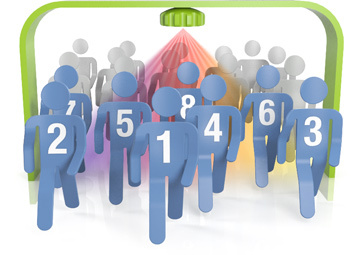
The systems presented on the market can be divided according to the principle of operation:
Infrared systems.
The system consists of an IR transmitter and an IR receiver. Between them there is an infrared ray. As soon as a person crosses it the sensor is triggered.
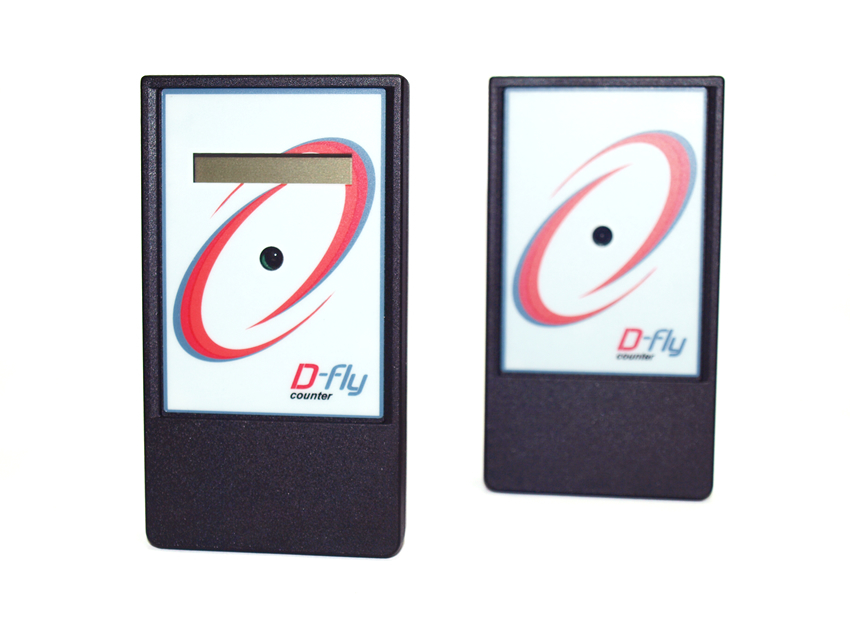
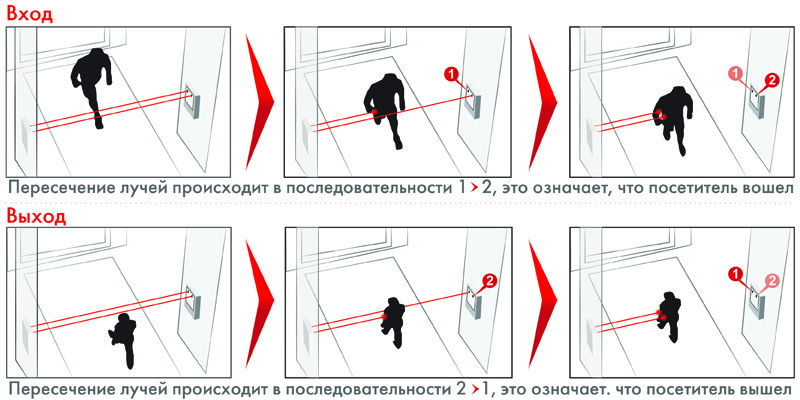
')
Horizontal systems are divided into unidirectional and bidirectional. Unidirectional - there is only one beam, when it crosses the counter is triggered. Bidirectional - there are two beams, depending on the order of their intersection counts on the input and output.
By type of power infrared sensors are divided into autonomous and non-autonomous. Autonomous are powered from batteries, not autonomous - from the mains.
By type of connection, they can be divided into connectable to a computer and not connected to a computer.
By type of installation - horizontal, vertical. Vertical - installation height not more than 3 m. Horizontal - passage width not more than 5 m. (In fact no more than 2 m).
Pros - cheap (set price from 3500-10000r, depending on the configuration), ease of installation and configuration. When connected to a computer, it is possible to build analytical reports, including direct data transfer to the office via the network. It is possible to integrate this type of system into an anti-theft gate.
Cons - high error, without connecting to a computer, it is possible to view reports only by day, not by hour, and the store manager does it. Quite easily deceived by sellers (beam overlap). With offline power, frequent battery replacement is required (on average once every three months). There is a possibility of using non-standard batteries in the sensor, whose cost is much higher and more difficult to find. (although it looks like the same AA batteries). The software often fails, self-reinstalling software without calling the provider is often problematic. Without a fixed fee, the technical support of the software is rather weak.
The overall impression is very inaccurate and in conjunction with a computer is a very whimsical system, which is easily deceived. But inexpensive. It is suitable if you need approximate data with a not very intense flow of buyers.
If the salary of sellers depends on conversion, then I do not recommend using this type of system.
Heat Sensor Systems
The person is visible as a heat stain. At the same time, double counting of visitors is excluded, as in the case of a ray crossing. It is possible to connect directly to the local network with data transfer to the office bypassing the computer. Can connect to a computer.
Installation height from 3 to 11 m.
Pros - higher accuracy, independence from lighting, it is difficult to deceive such a system.
Cons - can not be used near the heat curtains. They give a big margin of error if the entrance to the store is near the entrance to the street.
In my opinion the solution is not universal, has a number of restrictions on installation. The average price of the sensor order of several tens of thousands of rubles.
The general impression is in large retail chains, where store configurations can be very different, I would not use them. But to equip a large shopping center, where it is clearly prescribed in the architectural design is quite acceptable.
Systems running on video sensors.
The basis of such systems are sensors with video cameras (one camera in 2D and two in a 3D sensor).
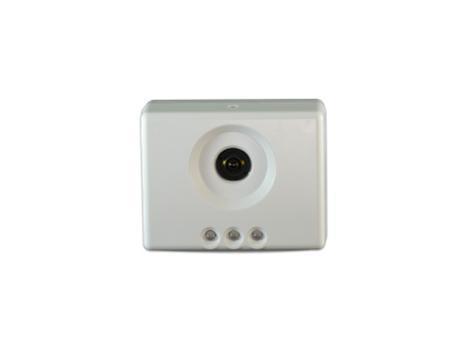
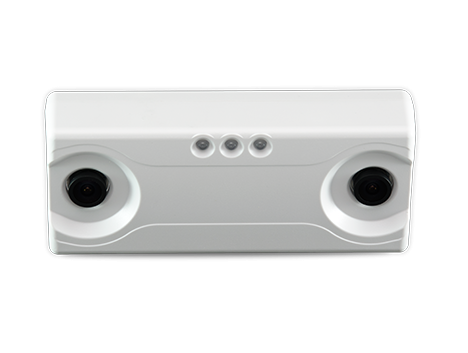
Pros - high accuracy of calculation, the ability to transfer data directly to the office via the network, bypassing the computer. The ability to build reports in a slice of up to 5 minutes. In the case of 3D sensors, you can approximately estimate the growth of customers and remove children from the traffic. It is almost impossible to deceive such a system. The accuracy of counting is 95-97%.
Cons - sensors depend on the lighting. With poor lighting, accuracy is reduced, 2D sensors may mistakenly take shadows for people, 3D sensors can count reflections as people.
However, in 3D sensors this is compensated by a flexible system of settings.
It is possible to set up a “buffer zone”; a person walking around the sales area will not be counted twice if he walks near the entrance. Those. the man came in, stood in the buffer zone and left. In this case, it will not be considered (in the picture below it is outlined in yellow).
The average cost of a 3D sensor is 70,000– 90,000 r.
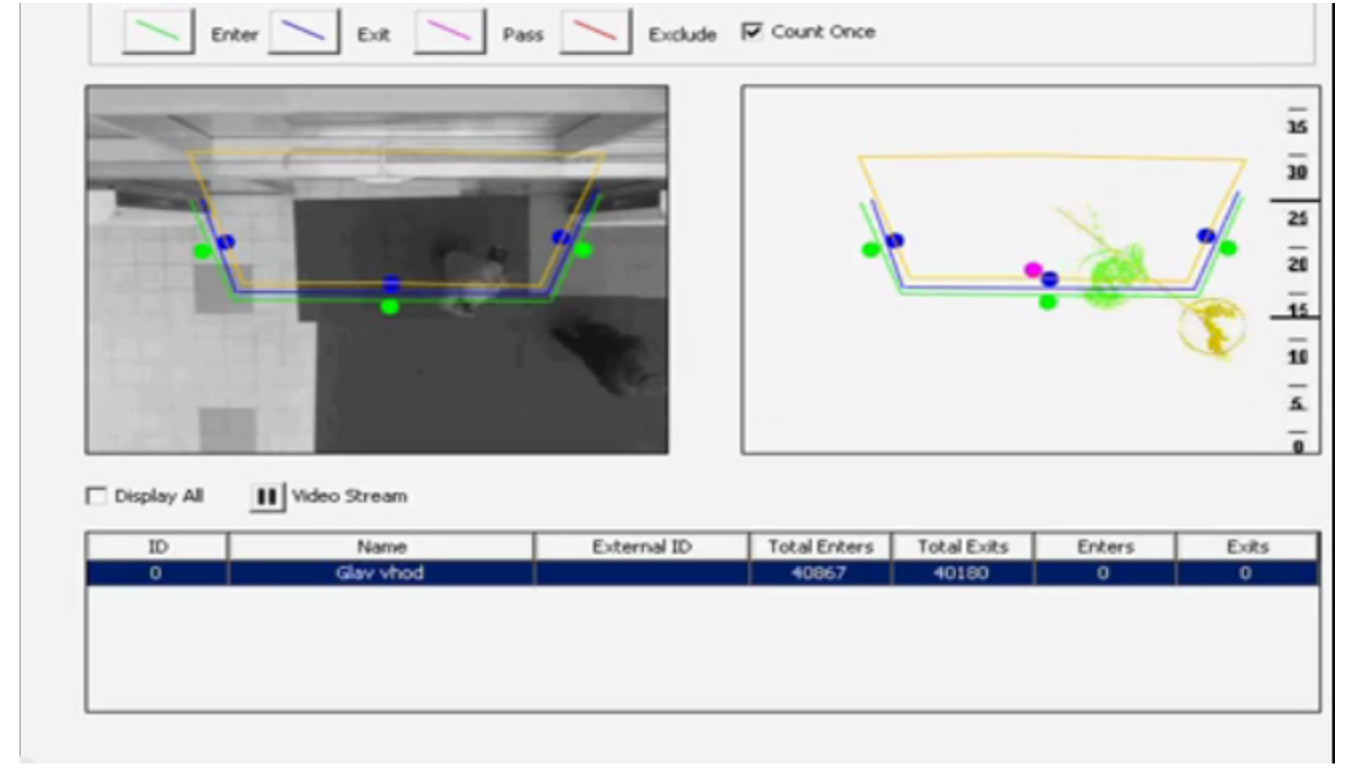
Overall impression - In my opinion, 3D sensors are the most versatile and accurate solution that is being actively implemented in many retail chains. Given the high accuracy of the calculation (95-97%) data from these sensors can be used when calculating the bonus part of the salary of sellers.
Conclusion
The system of counting visitors should be selected based on the tasks.
It should be remembered - after installation, the system must be serviced, and this also costs. Sometimes it is better to put the system more expensive, but in the long run, maintenance will be much cheaper.
And if the tasks change, then a system change may be necessary. Therefore, it is better to think in advance about the future.
If you are faced with the task of approximately estimating the flow of buyers, without using the data to calculate the bonuses of sellers, then I would recommend installing an inexpensive horizontal counting system on the IR beam without communicating with a PC, without autonomous power. In this variant there will be data with a high error, but at a minimal cost. When failures are easy to replace the sensors, they are not tied to computer equipment. The system consists of one node - the sensor itself. However, the number of visitors for the whole day will be known, without breaking down by hours and the manager may forget to send them or drive in the wrong number.
If you are faced with the task of estimating the number of visitors with the minimum error and using this data to calculate bonuses for sellers, then it is better to install 2D / 3D sensors. You will get high accuracy, the sellers will not be able to influence the data in any way, the data goes directly to the office, they have much less installation restrictions (you can equip all the shops, almost without taking into account such individual features as heat curtains, ceiling height, entrance width, distance from the exit to the street).
The system consists of two nodes - a sensor and a power supply. If there is no connection with the office, the sensor can operate autonomously for up to 10 days, saving data to the internal memory.
True, the office will have to install a server that will receive and process this data. Or order a data processing service from a third-party organization.
I would not recommend using intermediate solutions. By intermediate solutions, I mean IR sensors connected to a computer via a radio channel.
You will need to call third-party specialists and give them access to the PC, install additional software, train the staff to use it.
Also, such a system has more nodes that can fail (the sensors themselves, the base-receiver of data from the sensors, computer, software on the computer). In this case, data is transmitted from the sensor to the base via radio, which reduces the reliability of the system.
If you have 1-2 stores, then this solution is still acceptable. For a large network, it is not suitable.

The systems presented on the market can be divided according to the principle of operation:
- Infrared ray systems;
- Systems running on heat sensors;
- Systems with video sensors.
Infrared systems.
The system consists of an IR transmitter and an IR receiver. Between them there is an infrared ray. As soon as a person crosses it the sensor is triggered.


')
Horizontal systems are divided into unidirectional and bidirectional. Unidirectional - there is only one beam, when it crosses the counter is triggered. Bidirectional - there are two beams, depending on the order of their intersection counts on the input and output.
By type of power infrared sensors are divided into autonomous and non-autonomous. Autonomous are powered from batteries, not autonomous - from the mains.
By type of connection, they can be divided into connectable to a computer and not connected to a computer.
By type of installation - horizontal, vertical. Vertical - installation height not more than 3 m. Horizontal - passage width not more than 5 m. (In fact no more than 2 m).
Pros - cheap (set price from 3500-10000r, depending on the configuration), ease of installation and configuration. When connected to a computer, it is possible to build analytical reports, including direct data transfer to the office via the network. It is possible to integrate this type of system into an anti-theft gate.
Cons - high error, without connecting to a computer, it is possible to view reports only by day, not by hour, and the store manager does it. Quite easily deceived by sellers (beam overlap). With offline power, frequent battery replacement is required (on average once every three months). There is a possibility of using non-standard batteries in the sensor, whose cost is much higher and more difficult to find. (although it looks like the same AA batteries). The software often fails, self-reinstalling software without calling the provider is often problematic. Without a fixed fee, the technical support of the software is rather weak.
The overall impression is very inaccurate and in conjunction with a computer is a very whimsical system, which is easily deceived. But inexpensive. It is suitable if you need approximate data with a not very intense flow of buyers.
If the salary of sellers depends on conversion, then I do not recommend using this type of system.
Heat Sensor Systems
The person is visible as a heat stain. At the same time, double counting of visitors is excluded, as in the case of a ray crossing. It is possible to connect directly to the local network with data transfer to the office bypassing the computer. Can connect to a computer.
Installation height from 3 to 11 m.
Pros - higher accuracy, independence from lighting, it is difficult to deceive such a system.
Cons - can not be used near the heat curtains. They give a big margin of error if the entrance to the store is near the entrance to the street.
In my opinion the solution is not universal, has a number of restrictions on installation. The average price of the sensor order of several tens of thousands of rubles.
The general impression is in large retail chains, where store configurations can be very different, I would not use them. But to equip a large shopping center, where it is clearly prescribed in the architectural design is quite acceptable.
Systems running on video sensors.
The basis of such systems are sensors with video cameras (one camera in 2D and two in a 3D sensor).


Pros - high accuracy of calculation, the ability to transfer data directly to the office via the network, bypassing the computer. The ability to build reports in a slice of up to 5 minutes. In the case of 3D sensors, you can approximately estimate the growth of customers and remove children from the traffic. It is almost impossible to deceive such a system. The accuracy of counting is 95-97%.
Cons - sensors depend on the lighting. With poor lighting, accuracy is reduced, 2D sensors may mistakenly take shadows for people, 3D sensors can count reflections as people.
However, in 3D sensors this is compensated by a flexible system of settings.
It is possible to set up a “buffer zone”; a person walking around the sales area will not be counted twice if he walks near the entrance. Those. the man came in, stood in the buffer zone and left. In this case, it will not be considered (in the picture below it is outlined in yellow).
The average cost of a 3D sensor is 70,000– 90,000 r.

Overall impression - In my opinion, 3D sensors are the most versatile and accurate solution that is being actively implemented in many retail chains. Given the high accuracy of the calculation (95-97%) data from these sensors can be used when calculating the bonus part of the salary of sellers.
Conclusion
The system of counting visitors should be selected based on the tasks.
It should be remembered - after installation, the system must be serviced, and this also costs. Sometimes it is better to put the system more expensive, but in the long run, maintenance will be much cheaper.
And if the tasks change, then a system change may be necessary. Therefore, it is better to think in advance about the future.
If you are faced with the task of approximately estimating the flow of buyers, without using the data to calculate the bonuses of sellers, then I would recommend installing an inexpensive horizontal counting system on the IR beam without communicating with a PC, without autonomous power. In this variant there will be data with a high error, but at a minimal cost. When failures are easy to replace the sensors, they are not tied to computer equipment. The system consists of one node - the sensor itself. However, the number of visitors for the whole day will be known, without breaking down by hours and the manager may forget to send them or drive in the wrong number.
If you are faced with the task of estimating the number of visitors with the minimum error and using this data to calculate bonuses for sellers, then it is better to install 2D / 3D sensors. You will get high accuracy, the sellers will not be able to influence the data in any way, the data goes directly to the office, they have much less installation restrictions (you can equip all the shops, almost without taking into account such individual features as heat curtains, ceiling height, entrance width, distance from the exit to the street).
The system consists of two nodes - a sensor and a power supply. If there is no connection with the office, the sensor can operate autonomously for up to 10 days, saving data to the internal memory.
True, the office will have to install a server that will receive and process this data. Or order a data processing service from a third-party organization.
I would not recommend using intermediate solutions. By intermediate solutions, I mean IR sensors connected to a computer via a radio channel.
You will need to call third-party specialists and give them access to the PC, install additional software, train the staff to use it.
Also, such a system has more nodes that can fail (the sensors themselves, the base-receiver of data from the sensors, computer, software on the computer). In this case, data is transmitted from the sensor to the base via radio, which reduces the reliability of the system.
If you have 1-2 stores, then this solution is still acceptable. For a large network, it is not suitable.
Source: https://habr.com/ru/post/291522/
All Articles